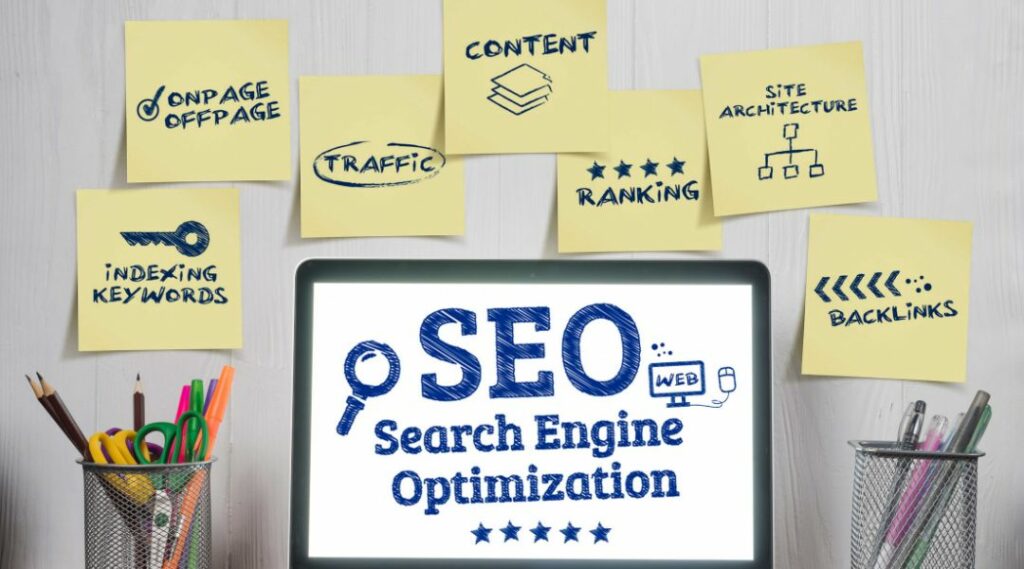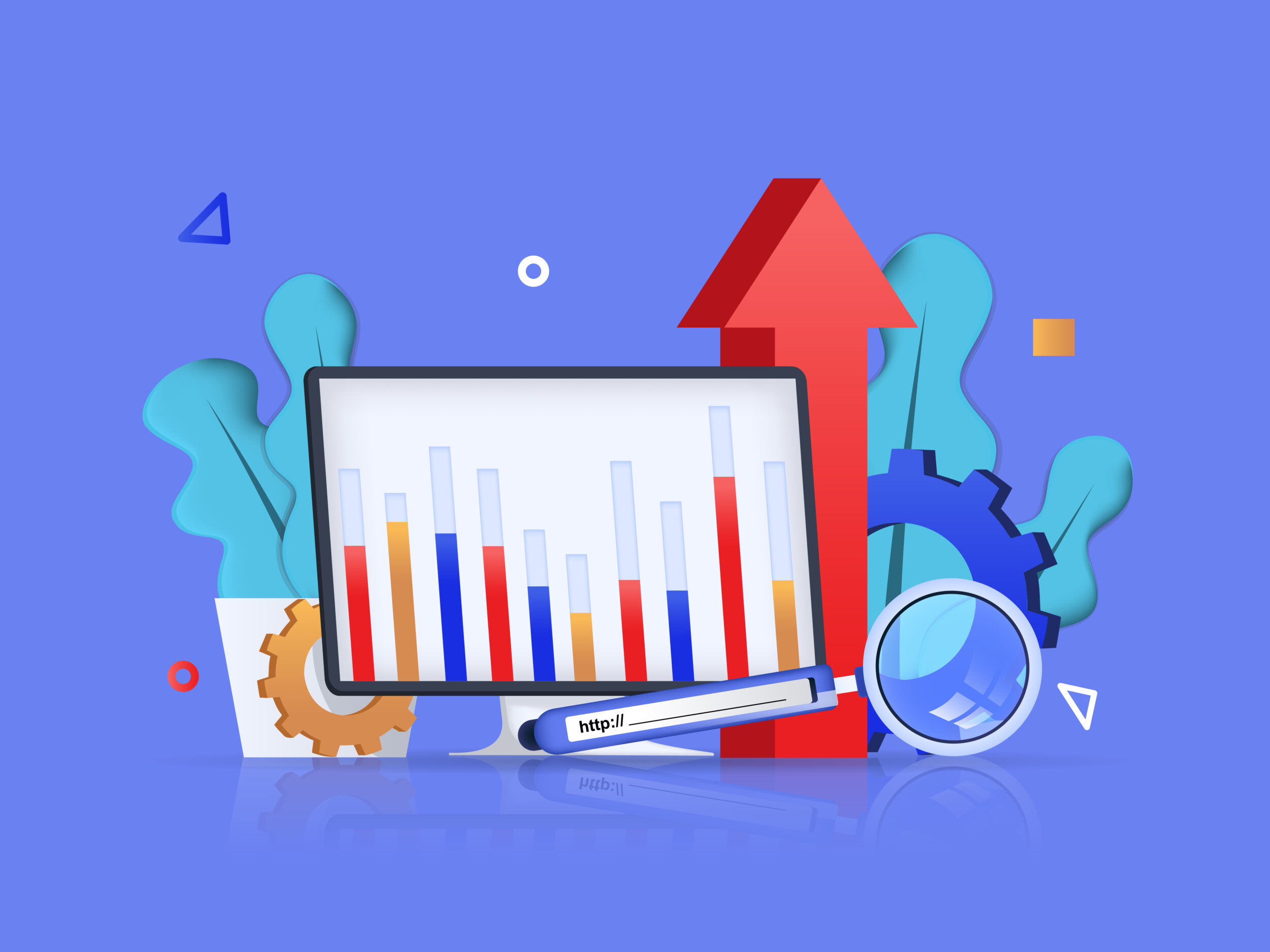Are you struggling to improve website traffic? You’re not alone. A recent poll from the Small Business Association showed that nearly 60% of small business owners in the US have had difficulty optimizing their online presence. But, with a few simple steps, you can increase website traffic and ensure more visibility for your business.
In this blog post, we’ll be discussing SEO, or search engine optimization, and how it can help boost website traffic by optimizing image quality, improving website speed, creating written content, and building backlinks as well as internal links throughout your site. Let’s take a look at all these key areas so you can start driving customers to your business today!

Conduct keyword research – Identify the keywords and phrases
When it comes to SEO, keywords are the foundation of your website. It’s important to conduct keyword research to identify the most relevant words and phrases that users search for when they’re looking for businesses like yours. This will help you create content that caters directly to their needs. There are several tools available that can help you with this process, such as Google AdWords Keyword Planner and Moz Keyword Explorer.
Types of Keywords to Target in SEO
Types of Keywords to Target in SEO can be broadly categorized into the following three types:
Short-tail Keywords
These are single words or phrases that are generally more popular and have higher search volumes than long-tail keywords. Examples include “marketing”, “fitness classes”, etc.
Long-tail Keywords
These are phrases that contain 3 to 4 words and provide more specific details about what people are looking for. They usually have lower search volume but higher conversion rates when used in SEO campaigns since they target a smaller group of people with very specific needs. Examples include “best yoga studios near me”, “small business marketing strategies”, etc.
Competitor Keywords
These are the most popular keywords your competitors use in their SEO campaigns. You can use tools like SpyFu to determine what keywords your competitors are targeting and use them in your SEO strategy if relevant.
When targeting keywords in SEO, it’s important to consider the search intent behind each keyword and ensure that the content on your website aligns with that intent.
Optimize on-page elements – Improve your website’s visibility on SERPs
Optimizing on-page elements is an essential part of improving your website’s SEO. Here are some ways to optimize your website’s on-page elements:
Title tags
Your website’s title tag is the main headline that appears on search engine results pages (SERPs). It’s essential to include relevant keywords in your title tag to help search engines understand what your website is about. Your title tag should also be concise and compelling to encourage users to click through to your website.
Meta descriptions
Your website’s meta description is a summary of your website’s content that appears below the title tag on SERPs. It’s crucial to include relevant keywords in your meta description to improve your website’s ranking. Your meta description should also be clear, concise, and compelling to encourage users to click through to your website.
Headings
Headings are used to structure your website’s content and make it more readable for users. Search engines also use headings to understand the content on your website. It’s essential to include relevant keywords in your headings to help search engines understand what your website is about.
Content
Your website’s content should be high-quality, relevant, and engaging. It’s essential to include relevant keywords in your content to improve your website’s ranking. However, it’s also crucial to avoid keyword stuffing and to write for your audience, not just search engines.
Structured data
Structured data is a way to organize your website’s content to help search engines better understand it. By using structured data, you can provide more context about your website’s content, which can improve your website’s visibility on SERPs.
By optimizing your on-page elements, you can improve your website’s visibility on SERPs and attract more traffic to your site.
Optimize Image Quality – How to Write Alt Text and Image Title Tags
People are more likely to stay on a website if it loads quickly and efficiently. Optimizing your website’s images is another essential part of improving its SEO. Here are some ways to optimize image quality:
- Use high-quality images: Make sure to use high-resolution images on your website, as they will appear better on SERPs.
- Compress images: Compressing large images can help reduce page load times, which can improve your website’s ranking on SERPs.
How to Write Alt Text and Image Title Tags
Images are an essential component of website page content, since almost 29% of search results include images, according to the MozCast Feature Graph. But search engines cannot interpret them. That’s why it’s important when uploading images on your website, to make sure to include relevant keywords in the filename and descriptive alt text of the image.
Alt text
Alt text is the text that appears when an image isn’t visible on a web page. It’s important to keep your alt text short, descriptive, and succinct so that it can easily be understood by search engines. It also improves user experience and provides context to screen readers who are visually impaired.
Add Image Title Tags
An image title tag is a text that appears when an image hovers over. It’s important to include relevant keywords in your title tags to help search engines better understand what the image is about.
These are just some of the ways you can improve your website’s SEO. With effective keyword research, on-page optimization, and image optimization, you can increase your website’s visibility on SERPs and attract more traffic to your site.
Optimize Your Site Speed – How to Optimize Website Speed and Quickly Load Pages
When it comes to improving website traffic, one key factor to consider is dwell time — the amount of time visitors remain on a site before moving on. Website speed plays an important role in this metric, as visitors tend to become frustrated if pages take too long to load.
If your site takes longer than three seconds for page loading, the chances of a visitor clicking away increase — and that’s bad news for website traffic.
Several factors can affect website speed. These include the number of files, server response time, CSS and JavaScript optimization, caching, etc. The following steps can help you optimize your website speed:
Minify code
Minifying code reduces file size by removing unnecessary characters or white space from HTML, CSS, and JavaScript without compromising functionality.
Use CDN (Content Delivery Network)
A CDN delivers content faster by storing copies of static content on multiple servers located around the world.
Leverage browser caching
Browser caching helps store website content in a user’s web browser, thereby reducing page loading times for repeat visitors.
Remember, you’ve got precious seconds to make an impression on your visitors — and a blazing-fast site is key to keeping them on board!
Create Quality Content – Share knowledge with potential customers
High-quality content is one of the most important factors when it comes to improving your website’s ranking on SERPs. Content should be informative, easy to understand, and relevant to the target audience. Additionally, formatting is also essential for improving user experience.
Here are some tips for creating quality content:
Know your target audience
Choose topics that are relevant to your target audience. It’s important to do research and thoroughly understand their needs, interests, and preferences. This will help you create more accurate and useful content that resonates with them.
Research keywords
Use keyword research tools to determine which topics and keywords you should use when creating content.
Write a Compelling Headline
A compelling headline entices readers and encourages them to click through and read further. Make sure your headline is short but powerful enough to grab attention quickly.
Use Subheadings
Subheadings break up the content and make it easier for readers to skim through. They also help search engines understand the overall structure of your post.
Include Relevant Images
Visuals can be an effective way to engage readers and make content more accessible. It’s always a good idea to include at least one relevant image in your blog post or article.
By creating quality content, you can improve your website’s visibility on SERPs, build trust with potential customers, and attract more traffic to your site. Quality content is crucial for improving SEO, so invest time and effort into producing it!

Link Building & Internal Linking – Increase Traffic and Grow Visibility
Link building and internal linking are two important tactics for improving website visibility on SERPs.
How does link-building work?
Link building refers to the process of obtaining other sites to link back to your website or blog.
Backlinks are important because they signal to search engines that other websites view your content as valuable and trustworthy. The more high-quality backlinks you have pointing to your website, the more likely your website is to rank higher in search engine results pages (SERPs).
Here are some techniques for Building High-Quality Backlinks:
Reach Out to Influencers
Connect with industry influencers and ask them to link to your website or blog. This can help you build relationships, increase visibility for your content, and get more backlinks.
Guest Posting
Write guest posts for other websites in your niche and include a link back to your website in the author bio section. This is an effective way to get high-quality backlinks from other sites and improve search engine rankings for your web pages.
Harness Social Media Platforms
Social media platforms like Facebook, Twitter, LinkedIn, etc., are great tools for connecting with potential customers as well as other industry professionals who may be willing to link back to your website.
How does internal linking work?
Internal link building, on the other hand, involves adding links within your content to related pages or posts on your website. This helps search engines crawl through all of the content on your site more easily and boosts the relevance of each page for a particular keyword or phrase. It also improves the user experience by helping visitors quickly navigate to related content.
Here’s how you can optimize your internal links:
Use Relevant Keywords
When adding internal links, use relevant keywords or phrases to make it clear where the link will take readers. This not only helps search engine crawlers understand what each page is about but also encourages visitors to click through.
Make It Easy To Find
Internal links should be easy to find and should be placed near related content. For example, if you’re linking from one blog post to another, add the link at the bottom of the post when it makes sense. Place internal links strategically throughout your content so that it makes sense for readers and search engines. Don’t force links where they don’t belong!
Create Descriptive Links
When creating links, avoid using generic phrases like “click here” or “read more.” Instead, use descriptive keywords that accurately describe the content the link is pointing to.
Limit The Number Of Links On Each Page
Having too many links on a page can overwhelm visitors and negatively affect UX. Keep your internal link count low by limiting them to important pages or posts only.
Keep Your Links Up To Date
If you have links that are no longer relevant, make sure to update them or remove them entirely. This will ensure that visitors are directed to the most up-to-date content on your website.
Invest time and effort into these activities, and watch your website grow!
Monitor Your Progress – Making Data-Driven SEO Decisions
Monitoring your SEO progress is a key part of any successful SEO strategy. You need to track the performance of your website or blog to understand what’s working and what needs improvement.
Key metrics you should monitor for SEO success:
Organic Traffic
This metric shows how many visitors are coming to your website through organic search engine results. Track this over time to see if your SEO efforts are paying off.
Keyword Rankings
Monitor which keywords you’re ranking for and how those rankings change over time. Doing so will help you determine which strategies are working best and pinpoint areas where there is room for improvement.
Backlinks
Keep an eye on the number of backlinks pointing to your website. Quality backlinks are important for SEO, so track the number of links from high-authority websites.
Search Engine Visibility
Monitor your visibility on search engine results pages (SERPs). This metric will show you how often your content appears and how visible it is in SERPs.
By consistently tracking these key metrics, you’ll have a better understanding of where your SEO efforts are succeeding in their aim to improve website traffic.
Making Data-Driven SEO Decisions to Improve Website Traffic
Data-driven decision-making is a powerful way to optimize your SEO performance. By leveraging data and research, you can make informed decisions that will yield better results than guesswork or trial and error. Here’s how you can use data to make smarter SEO decisions:
Research
Gather as much data as possible about your target audience, competitors, and industry trends. This information will help you formulate an effective strategy for optimizing your website or blog.
Analyze
Take a close look at the numbers. Look for patterns in the data that could provide insights into which strategies are working best and which need improvement.
Test
Don’t be afraid to experiment. Try different tactics and test their effectiveness. This will allow you to make more informed decisions about which strategies are most successful and worth investing in further.
Monitor and Adjust
Track key metrics over time and evaluate progress against your goals. This will help you understand which strategies are yielding the best results so that you can focus or adjust on those areas where you’re seeing the most success.
By leveraging data, insights, and research, you’ll be able to make smarter decisions that improve your SEO performance and help drive business growth.

Key Takeaways
Following good SEO practices is essential for improving website traffic and growing a business.
• Building and maintaining good internal links is essential for SEO success.
• Use descriptive keywords when creating links to ensure visitors understand the content they’re being directed to.
• Limit the number of links on each page and keep your links up-to-date.
• Monitor key metrics such as organic traffic, keyword rankings, backlinks, and search engine visibility to track progress over time.
• Make data-driven decisions by researching, analyzing, testing, and adjusting based on the results you get from tracking these metrics.
By following these steps, you should be able to achieve SEO success and grow your business.
XYZ Marketing To Elevate Your SEO Strategy
SEO is an ongoing process that requires time and resources to effectively implement. With so many tactics to consider, it can be difficult and time-consuming to figure out the best approach for your business. Hiring a professional like XYZ Marketing can help you manage your SEO efforts and ensure that you are getting the most out of your website.
We have the experience and knowledge needed to guide you in creating and executing successful strategies that will help drive relevant traffic to your website and increase conversions. XYZ Marketing will provide you with the knowledge and experience necessary to ensure that your website meets all of the current SEO standards and reaches its full potential.
With our help, you can save time and money while ensuring success for your business. Don’t hesitate – to invest in professional SEO services now so you can start seeing results sooner!









